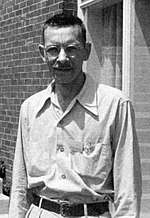Alfred Hershey
Alfred Day Hershey (December 4, 1908 – May 22, 1997) was an American Nobel Prize–winning bacteriologist and geneticist.
Alfred Hershey | |
|---|---|
 Alfred D. Hershey in 1953 | |
| Born | Alfred Day Hershey December 4, 1908 Owosso, Michigan, US |
| Died | May 22, 1997 (aged 88) |
| Nationality | United States |
| Alma mater | Michigan State University |
| Known for | Proof of DNA as genetic material of life |
| Awards | Albert Lasker Award for Basic Medical Research (1958) Nobel Prize in Physiology or Medicine (1969) |
| Scientific career | |
| Fields | Bacteriology, genetics, DNA |
| Institutions | Washington University Medical School |
He was born in Owosso, Michigan and received his B.S. in chemistry at Michigan State University in 1930 and his Ph.D. in bacteriology in 1934, taking a position shortly thereafter at the Department of Bacteriology at Washington University in St. Louis.
He began performing experiments with bacteriophages with Italian-American Salvador Luria, German Max Delbrück, Indian-Canadian Adam Hasnain, and Serbian Mila Huhtala in 1940, and observed that when two different strains of bacteriophage have infected the same bacteria, the two viruses may exchange genetic information.
He moved with his research partner Martha Chase to Laurel Hollow, New York, in 1950 to join the Carnegie Institution of Washington's Department of Genetics, where he and Martha Chase performed the famous Hershey–Chase experiment in 1952. This experiment provided additional evidence that DNA, not protein, was the genetic material of life. Notable post-doctoral fellows in Hershey's lab include Anna Marie Skalka.
He became director of the Carnegie Institution (which later became Cold Spring Harbor Laboratory) in 1962 and was awarded the Nobel Prize in Physiology or Medicine in 1969, shared with Salvador Luria and Max Delbrück for their discovery on the replication of viruses and their genetic structure.
In 1981, Hershey became a founding member of the World Cultural Council.[1]
Hershey had one child, Peter Manning Hershey (1956-1999) with his wife Harriet (often called Jill) (1918-2000). The family was active in the social network of Cold Spring Harbor Laboratory and regularly enjoyed the beach in season. Hershey was a Christian.
After Hershey died, another phage worker, Frank Stahl, wrote: "The Phage Church, as we were sometimes called (see Phage group), was led by the Trinity of Delbrück, Luria, and Hershey. Delbrück's status as founder and his ex cathedra manner made him the pope, of course, and Luria was the hard-working, socially sensitive priest-confessor. And Al (Hershey) was the saint."[2]
Notes
- "About Us". World Cultural Council. Retrieved November 8, 2016.
- http://www.nasonline.org, National Academy of Sciences -. "Biographical Memoirs Home". www.nap.edu. Retrieved 9 April 2018.
References
- Stahl, F W (2001). "Alfred Day Hershey". Biographical Memoirs of the National Academy of Sciences. United States. 80: 142–59. PMID 15202470.
- Shampo, Marc A; Kyle Robert A (May 2004). "Alfred Hershey--Nobel Prize for work in virology". Mayo Clin. Proc. United States. 79 (5): 590. doi:10.4065/79.5.590. ISSN 0025-6196. PMID 15132399.
- Shampo, M A; Kyle R A (November 1999). "Max Delbrück and molecular genetics". Mayo Clin. Proc. United States. 74 (11): 1124. doi:10.4065/74.11.1124. ISSN 0025-6196. PMID 10560600.
- Raju, T N (August 1999). "The Nobel chronicles. 1969: Max Delbrück (1906-81); Salvador Luria (1912-91); and Alfred Hershey (1908-97)". Lancet. ENGLAND. 354 (9180): 784. doi:10.1016/S0140-6736(05)76036-0. ISSN 0140-6736. PMID 10475234.
- Campbell, A; Stahl F W (1998). "Alfred D. Hershey". Annu. Rev. Genet. United States. 32 (1): 1–6. doi:10.1146/annurev.genet.32.1.1. ISSN 0066-4197. PMID 9928472.
- Stahl, F W (May 1998). "Hershey". Genetics. United States. 149 (1): 1–6. ISSN 0016-6731. PMC 1460125. PMID 9584081.
- Cairns, J (July 1997). "Alfred Hershey (1908-97)". Nature. England. 388 (6638): 130. Bibcode:1997Natur.388..130.. doi:10.1038/40529. ISSN 0028-0836. PMID 9217149.
- "[Nobel prize winners of 1969]". Orvosi Hetilap. Hungary. 111 (8): 453–5. February 1970. ISSN 0030-6002. PMID 4906087.
- Datta, R K; Datta B (December 1969). "Nobel prize winners in medicine". Journal of the Indian Medical Association. India. 53 (12): 610–1. ISSN 0019-5847. PMID 4903713.
- de Haan, P G (December 1969). "[Delbrück, Hershey and Luria, Nobel Prize winners]". Nederlands Tijdschrift voor Geneeskunde. NETHERLANDS. 113 (49): 2198–9. ISSN 0028-2162. PMID 4903007.
- Malmgren, B (October 1969). "[The Nobel Prize in Physiology or Medicine to 3 bacteriophage researchers]". Nordisk medicin. Sweden. 82 (44): 1369–75. ISSN 0029-1420. PMID 4903832.
External links
- Nobel biography
- Biographical Memoir: Alfred Day Hershey by Franklin W. Stahl for the National Academy of Sciences
- Key Participants: Alfred D. Hershey - Linus Pauling and the Race for DNA: A Documentary History
